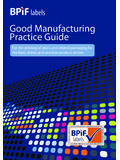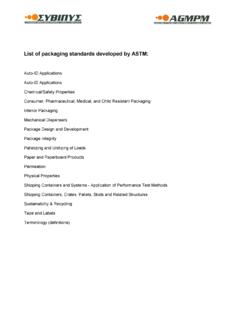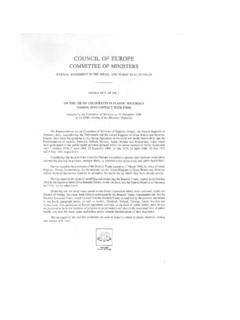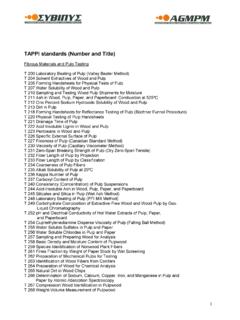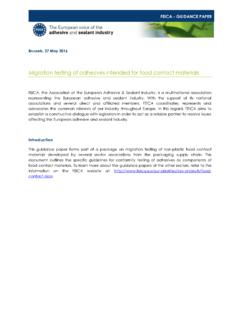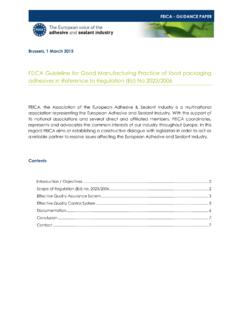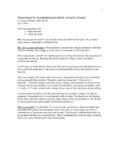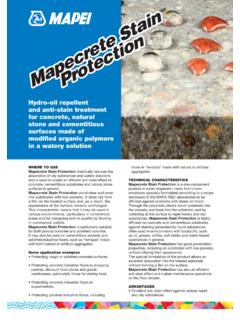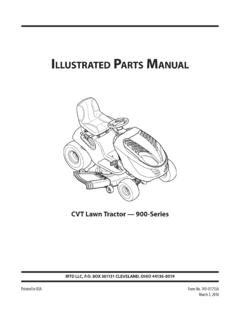Transcription of Ma t e r i a l s 7. Me t a l Pa c k a g i n g fo o d s t u ...
1 Pa c k a g i n g Ma t e r i a l s 7. Me t a l Pa c k a g i n g f o r fo o d s t u f f sILSI EuropeReport SeriesRe p oR t Prepared under the responsibility of the ilsi Europe Packaging Materials Task ForceAbout ILSI / ILSI EuropeThe International Life Sciences Institute (ILSI) is a non-profit, worldwide foundation established in 1978 to advance the understanding of scientific issues relating to nutrition, food safety, toxicology, risk assessment and the environment. By bringing together scientists from academia, government, industry and the public sector, ILSI seeks a balanced approach to solving problems of common concern for the well being of the general public. ILSI is headquartered in Washington, DC, USA. Branches include Argentina, Brazil, Europe, India, Japan, Korea, Mexico, North Africa and Gulf Region, North America, North Andean, South Africa, South Andean, Southeast Asia Region, the focal point in China, and the ILSI Health and Environmental Sciences Institute (HESI).
2 ILSI is affiliated with the World Health Organization as a non-governmental organisation (NGO) and has specialised consultative status with the Food and Agriculture Organization of the United Europe was established in 1986 to identify and evaluate scientific issues related to the above topics through symposia, workshops, expert groups and resulting publications. The aim is to advance the understanding and resolution of scientific issues in these areas. ILSI Europe is funded primarily by its industry publication is made possible by support of the ILSI Europe Task Force on Packaging Materials, which is under the umbrella of the Board of Directors of ILSI Europe. ILSI policy mandates that the ILSI and ILSI branch Boards of Directors must be composed of at least 50% public sector scientists; the remaining directors represent ILSI s member companies.
3 Listed hereunder are the ILSI Europe Board of Directors and the ILSI Europe Task Force on Packaging Materials industry Europe Board of Directors Non-industry membersProf. M. Carruba, University of Milan (IT)Prof. G. Eisenbrand, University of Kaiserslautern (DE)Prof. A. Grynberg, Universit Paris Sud INRA (FR)Dr. I. Knudsen, Danish Institute for Food and Veterinary Research (retired) (DK)Dr. M. Kovac, Permanent Representation of the Slovak Republic to FAO and WFP (SK)Prof. em. G. Pascal, National Institute for Agronomic Research - INRA (FR)Prof. S. Strain, University of Ulster (UK)Prof. V. Tutelyan, National Nutrition Institute (RU)Prof. G. Varela-Moreiras, University San Pablo-CEU of Madrid (ES)Prof. em. P. Walter, University of Basel (CH)ILSI Europe Packaging Material Task Force industry members Coca-Cola European Union GroupCognisDow EuropeGroupe DanoneH J HeinzKraft FoodsNestl NumicoSwiss Quality Testing Services (SQTS)Tetra Pak ResearchValspar Corporation Industry membersMr.
4 R. Fletcher, Kellogg (IE)Dr. A. Grant, Kraft Foods (UK)Dr. Knowles, Coca-Cola European Union Group (BE)Dr. G. Kozianowski, S dzucker (DE)Prof. T. Mattila-Sandholm, Valio (FI)Dr. M ller, Procter & Gamble (DE)Dr. G. Thompson, Groupe Danone (FR)Prof. P. van Bladeren, Nestl (CH)Prof. van Gelder, Numico (NL)Dr. H. Zevenbergen, Unilever (NL)PACKAGING MATERIALS7. METAL PACKAGING FOR FOODSTUFFSBy Peter Oldring and Ulrich NehringREPORTPREPARED UNDER THE RESPONSIBILITY OF THE ILSI EUROPE PACKAGING MATERIALS TASK FORCESEPTEMBER 2007 2007 ILSI EuropeAll rights reserved. No part of this publication may be reproduced, stored in a retrieval system, or transmitted, in any form or by any means, electronic, mechanical, photocopying, recording, or otherwise, without the prior written permission of the copyright holder. Authorisation to photocopy items for internal or personal use is granted by ILSI Europe for libraries and personal users.
5 ILSI , A Global Partnership for a Safer, Healthier World. , and the International Life Sciences Institute (ILSI) logo image of the microscope over the globe are registered trademarks of the International Life Sciences Institute and licenced for use by ILSI Europe. The use of trade names and commercial sources in this document is for purposes of identification only and does not imply endorsement by ILSI Europe. In addition, the views expressed herein are those of the individual authors and/or their organisations and do not necessarily reflect those of ILSI more information about ILSI Europe, please contact:ILSI Europe E. Mounier 83, Box 6B-1200 BrusselsBelgiumPhone: (+32) 2 771 00 14 Fax: (+32) 2 762 00 44E-mail: in BelgiumD/2007 90-78637-06-6 ContentsFOREWORD 4 INTRODUCTION 5 METALS AND ALLOYS USED FOR FOOD PACKAGING 7 TYPES OF METAL PACKAGING 8 CAN COATINGS 14 REGULATORY ASPECTS 24 SAFETY EVALUATION 30 ENVIRONMENTAL REGULATIONS 33 GENERAL CONCLUSIONS 34 REFERENCES 35 LIST OF ACRONYMS 38 GLOSSARY 39 Authors: Peter Oldring, Valspar Corporation (UK) and Ulrich Nehring, Institute Nehring GmbH (DE)Scientific Reviewer: Rinus Rijk, Nutrition and Food Research Institute (NL) and Thomas Simat, Technical University of Dresden (DE)Report Series Editor: Kevin Yates (UK)Coordinator: Tanja Wildemann, ILSI Europe (BE)Pa c k a g i n g m a t e r i a l s: 7.
6 M e t a l P a c k a g i n g f o r f o o d s t u f f s3 Forewordhe present report is the seventh in the report series on food packaging materials, which was commissioned by the ILSI Europe Packaging Materials Task Force. The report series aims to give a concise overview on specific packaging materials with regard to their uses as packaging material, their basic chemistry, safety and toxicology, regulation and environmental fate. The reports mainly address an audience in the packaging-producing and packaging-using reports have been published on the following topics and can be obtained as a hard copy via or be downloaded from: +Series/ PET Packaging Materials (2000) Polystyrene for Food Packaging Applications (2002) Polypropylene as a Packaging Material for Foods and Beverages (2002) Polyethylene for Food Packaging Applications (2003) Polyvinyl Chloride for Food Packaging Applications (2003) Paper and Board for Food Packaging Applications (2004)4Pa c k a g i n g m a t e r i a l s: 7.
7 M e t a l P a c k a g i n g f o r f o o d s t u f f sT5 IntrodUCtIonBackgroundMetal packaging plays an important role in the process of food preservation. The common expression used to describe such a process is canning . Canned food has become an important part of the human diet in developed countries during the past century. It is of particular value in those parts of the world where no or limited refrigeration exists for storing food. It is a means of safely preserving foodstuffs without microbiological packaging has a double function as a protection against any external influence on the foodstuff during heat treatment and storage and as a sales and information pack. The basic requirement for such a package is the hermetic tightness of the container. The food, which is sterilised by the heat process, ought to be protected against any re-infection with microorganisms or any other kind of influence from the outside.
8 This rather complex requirement is often described as container integrity . Metals are used for many food contact applications, such as saucepans and coffee pots as well as packaging. This monograph only considers metal packaging for foodstuffs. As many of these contain an organic layer (referred to as coating) on the metal surface between the foodstuff and the metal, the topic of coatings has been given a special of metal packagingFood is packed into a wide range of containers, some of which consist of all metal whilst others have metal components. The different types of metal packaging include: Beer and soft drink cans Food cans Drums and pails Aerosol containers Tubes Open trays Caps and closures ( lids on glass jars and bottle tops) Lids ( for yoghurt and butter containers).Food cans are packed under ambient pressure or vacuum whilst beer and carbonated beverage cans are packed under pressure.
9 Another difference is in the processing that occurs once the can is filled and the lid is seamed on. Soft drinks typically undergo no further treatment. Beer is frequently pasteurised in the can. Many foods are filled hot and are cooked in the can, under a wide range of conditions. This gives food that can be preserved for long periods (a 5-year shelf life is not uncommon) without the need for preservatives. The sterilising processes are controlled to assure microbiological safety during the foreseen shelf life. Pa c k a g i n g m a t e r i a l s: 7. m e t a l P a c k a g i n g f o r f o o d s t u f f sUse of coatings for metal packaging Many metal packagings (typically cans, containers, caps and closures) are normally coated on one or both sides. The inside (food contact) coating is referred to as an internal coating, lacquer or enamel and the outside as external coating, enamel, ink or varnish.
10 Unlike many other applications, can coatings are normally thermally processed (stoved or baked). Metal packaging is coated for many reasons:Internal (food contact) coatings: Provide protection of the contents from the metal iron pick-up in beer or discolouration of some dark-coloured fruits, such as plums and strawberries, due to metal contact Provide protection of the metal can from the contents of the can acidic soft drinks (which may corrode uncoated metal) or some fish, meats and soups (which may cause sulphur staining).External (non-food contact) coatings: Provide protection of the metal from the environment atmospheric corrosion Support decoration, labelling and consumer information Influence mobility (friction) of the article during filling operations beverage cans can only be filled with an external decoration, which provides the necessary friction (mobility) to pass through the filling the purpose of this monograph, only internal coatings have been considered.
